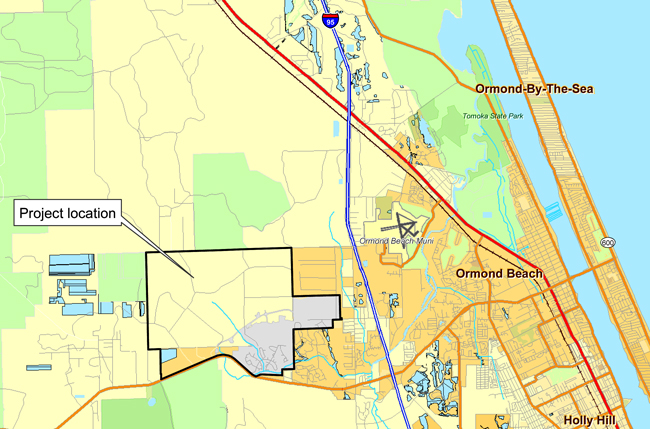
Hunter’s Ridge is a 5,000-acre development that straddles the Volusia–Flagler county line, with 3,800 of those acres in Flagler. It was first proposed in 1989 as a 6,500-home development, and first approved in Volusia and Flagler in 1991. It has gone through numerous changes since, including ownership. Some 982 homes have been built on the Volusia side, in Ormond Beach. None has been built in Flagler yet. The current developer foresees 3,000 housing units in Flagler when the project is done.
Click On:
- 20 Years On, With $1.17 Million Pay-off, County Approves Hunter’s Ridge Megadevelopment
- Delinquent on Taxes and Other Dues, Hunter’s Ridge Development Wants More Favors
- Dogged Duo: Nate McLaughlin and Milissa Holland Take Their County Commission Oath
- Commission Money Race: Mori Hosseini and Other Developers Bankrolling Abbott’s Bid
In yet another run at amending the plan, the Hunter’s Ridge developer has been seeking to increase housing density within a 977-acre portion of the development on the Flagler side. The change would enable the development to increase the number of homes in that portion from 949 to 1,275. They’d be smaller homes on smaller lots. To do that, Developer Alan Feker had to secure the Flagler County Commission’s approval of a land-use change enabling the higher density.
Wednesday evening, the commission voted 3-2 to reject Feker’s application for the increased density (but not the land-use change: the commission approved the zoning change from timberland to low- and medium density, mixed-use development). Commission Chairman George Hanns joined Commissioners Milissa Holland and Alan Peterson in the unusual split, with Barbara Revels and Bob Abbott in dissent. The vote came down to two issues Holland and Peterson raised: First, the Hunter’s Ridge developers have chronically changed plans and failed to meet contractual obligations, Holland said, especially a $1 million pay-out to the county in exchange for no longer having to build a golf course for the county (that golf course had been part of the original plan.)
Second, Peterson saw no need for increasing the development’s density just to enable the developer to make Hunter’s Ridge more lucrative. “Higher density means yes, a chance for more business or commercial development, but what kind of commercial development are we talking about? I don’t intend to vote for this tonight because the density bothers me, the DRI bothers me,” Petsron said, referring to the acronym for large developments called “Developments of Regional Impact.” Earlier, Planning Director Adam Mengel had told the commission that the county administration had accepted the developer’s reasoning that higher density would be needed to make the development’s industrial and commercial centers viable. But those justifications weren’t part of the written rationale. “So I’m disappointed with staff that you haven’t justified in my mind or written here why you bought into it,” Peterson said.
The discussion at the commission meeting underscored a notable rift in how commissioners see their role—and the role of government in setting land-use regulation—at least with regard to this particular development. Revels and Abbot were willing to work with the developer’s evolving needs and market limitations. The developer is making clear that it won’t be able to make money developing Hunter’s Ridge, in the current climate, unless it makes its housing units more easily sellable, and its commercial and industrial zones more attractive to commerce. No businesses will be attracted by empty houses. The downside is making the development thicker with buildings than greenery—more sprawl, less air. Several residents in the audience objected on those grounds.
That raised the question of how far the county should go to accommodate a developer’s market pressures. Holland was categorical: it’s not the government’s place to provide such favors to a developer, at other residents’ expense, although Holland’s decision was just as clearly influenced by the developer’s erratic record.
“This has come back and forth to us, since I’ve been on this board I can’t tell you how many times,” Holland said, “It’s been modified I can’t tell you how many times. If you look at the original development order, there’s been things that this developer has not followed through with, including talking about the parts of land under conservation. They had an agreement with Florida Audubon society, you know, they’ve needed to follow through with things that they’ve not followed through with, consistently. That concerns me. So here we are today, discussing the substantial deviation area”—a substantial deviation is government-speak for essentially a big change in zoning rules—“with an entity that has not followed through with anything from the original development order. What makes me sit here and think that we keep entering into these types of agreements and they keep getting modified and modified and pushed back and pushed back until, I don’t know, maybe the market picks up, and things change? But that’s not our role and that’s not our job. We’re here to create growth-management issues and do what’s responsible for the people of Flagler County, and I just don’t feel like we’re doing that. I think we have to stop giving at one point, and they keep coming and asking and not following through with what we agree upon as a board.”
Holland earlier zeroed in on another troubling issue: the developer’s failure to pay the county that $1 million in exchange for the waiver on building a golf course.
“I thought we entered into a contractual agreement with them separate from the development,” Holland said, referring to the arrangement over the golf course.
“That’s right,” Mengel said.
“That’s an issue.”
“It’s certainly out there,” Mengel said.
“That’s quite a few months ago. They’ve not signed the document?”
“That’s my understanding, yes ma’am.”
“That’s a problem,” Holland said. “And the million-dollar installment has not been paid because they’ve not executed the contract.”
“That’s correct.”
“So what was agreed upon previously by this board has not been followed through contractually by the other party.”
“Yes ma’am, that’s my understanding.”
“Thank you.”





























Leave a Reply